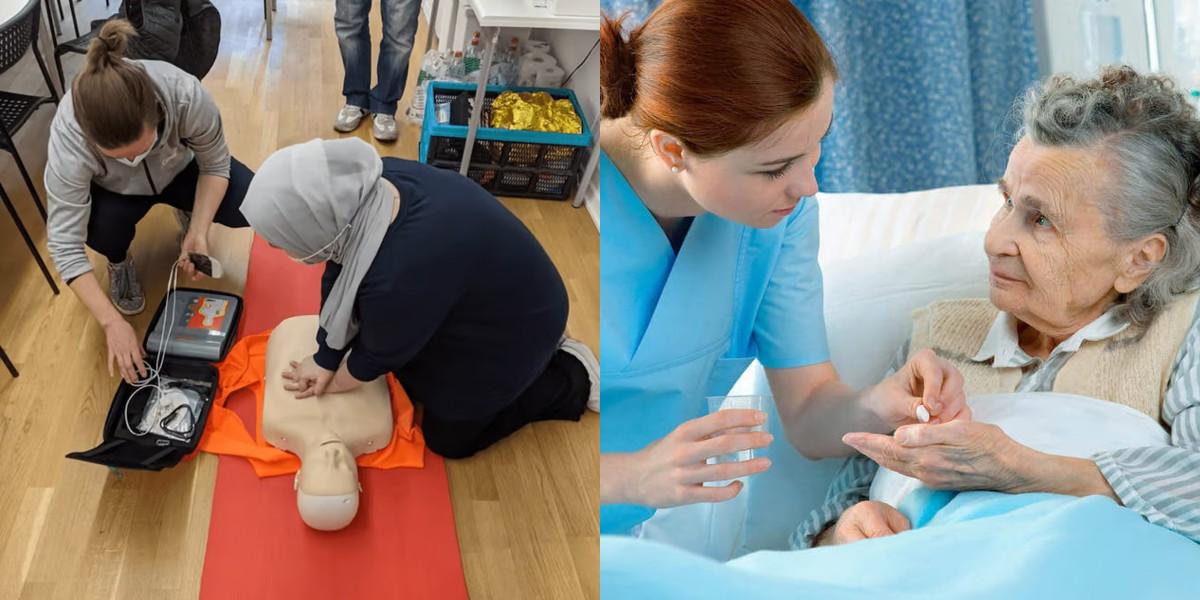CPR-BLS vs Medication Aide

Want personalized recommendations?
Let's match you to the right program

Key Points:
- CPR-BLS providers perform emergency life-saving techniques, while Medication Aides assist with medication administration and monitoring patient health.
- CPR-BLS providers typically earn less than Medication Aides, who often have higher salaries due to their specialized medical training.
- CPR-BLS jobs can be found in various settings, while Medication Aide positions are more commonly available in healthcare facilities like nursing homes and hospitals.
- CPR-BLS training is often shorter and can be done online, whereas Medication Aide training requires in-person classes and certification.
- CPR-BLS training is generally less expensive and shorter than Medication Aides training.
When it comes to vocational training, there are a wide variety of options available to students. Two popular choices include CPR-BLS (Basic Life Support) and Medication Aide training. While both of these programs focus on healthcare, there are some key differences between them. In this blog post, we will explore what CPR-BLS and Medication Aide training entail, discuss the differences between the two, and examine the career outlook and salary potential for each.
Article continues after recommendations
Recommended for you
What is CPR-BLS and Medication Aide?
CPR-BLS: CPR-BLS, or Basic Life Support, is a training program that teaches individuals how to respond in emergency situations where immediate life-saving techniques are required. This includes performing CPR (Cardiopulmonary Resuscitation), using an AED (Automated External Defibrillator), and providing basic first aid. CPR-BLS certification is often required for healthcare professionals such as nurses, doctors, and emergency medical technicians.
Medication Aide: Medication Aide training, on the other hand, focuses on medication administration and assisting with the daily living activities of patients in long-term care facilities. Medication Aides are responsible for administering medications under the supervision of a licensed nurse, as well as monitoring patients for any adverse reactions. This training program is typically geared towards individuals who want to work in nursing homes, assisted living facilities, or similar healthcare settings.
Difference between CPR-BLS and Medication Aide
While both CPR-BLS and Medication Aide training programs fall under the umbrella of healthcare, there are some key differences between the two:
Focus: CPR-BLS training primarily focuses on emergency response and life-saving techniques, whereas Medication Aide training focuses on medication administration and patient care in long-term care facilities.
Scope of Practice: CPR-BLS certification allows individuals to respond to emergency situations and provide immediate care until more advanced medical help arrives. Medication Aides, on the other hand, have a more specific role in administering medications and assisting with daily living activities of patients in long-term care settings.
Certification Requirements: CPR-BLS certification is often required for healthcare professionals, such as nurses and doctors, and needs to be renewed periodically. Medication Aide certification requirements vary by state but typically involve completing a training program and passing a competency exam.
CPR-BLS vs Medication Aide: Job Description
CPR-BLS: Individuals with CPR-BLS certification are often employed in healthcare settings where they may be the first responders in emergency situations. Their job duties may include:
- Performing CPR and other life-saving techniques
- Using an AED to restore normal heart rhythm
- Providing basic first aid
- Assisting with emergency medical procedures
- Collaborating with other healthcare professionals to ensure patient safety
Medication Aide: Medication Aides work in long-term care facilities, such as nursing homes or assisted living facilities, and are responsible for medication administration and patient care. Their job duties may include:
- Administering medications according to prescribed schedules
- Monitoring patients for any adverse reactions to medications
- Assisting with activities of daily living, such as bathing and dressing
- Documenting medication administration and patient observations
- Collaborating with licensed nurses and other healthcare professionals to ensure quality care
CPR-BLS vs Medication Aide: Education and Training
CPR-BLS: CPR-BLS training programs are typically shorter in duration compared to Medication Aide programs. These programs often consist of a combination of classroom instruction and hands-on practice. Certification is typically obtained through an accredited organization, such as the American Heart Association or the Red Cross.
Medication Aide: Medication Aide training programs are more comprehensive and typically require a longer time commitment. These programs cover topics such as medication administration, medical terminology, infection control, and patient care. Certification requirements vary by state, but programs are often offered through community colleges, vocational schools, or healthcare facilities.
Get courses selected just for you
Try our powerful search engine
CPR-BLS vs Medication Aide: Career Outlook and Salary
CPR-BLS: The career outlook for individuals with CPR-BLS certification is generally favorable. With the increasing emphasis on emergency preparedness and the need for trained professionals in healthcare settings, the demand for CPR-BLS certified individuals is expected to continue to grow. The salary for CPR-BLS certified individuals varies depending on factors such as location, experience, and job setting. According to the Bureau of Labor Statistics, the median annual wage for emergency medical technicians and paramedics, who often have CPR-BLS certification, was $35,400 in May 2020.
Medication Aide: The career outlook for Medication Aides is also positive, as the demand for healthcare workers in long-term care facilities is expected to increase due to the aging population. The salary for Medication Aides varies depending on factors such as location, experience, and employer. According to Salary.com, the average annual salary for Medication Aides in the United States is $33,200 as of July 2021.
Final Thoughts
In conclusion, both CPR-BLS and Medication Aide training programs offer valuable skills and opportunities for individuals interested in healthcare. CPR-BLS certification is essential for healthcare professionals who may encounter emergency situations, while Medication Aide training prepares individuals for a role in administering medications and providing patient care in long-term care facilities. The choice between these two programs ultimately depends on an individual's interests, career goals, and desired job responsibilities.
Dreambound's programs are accessible in different locations. For additional details on these two vocations, please visit:




